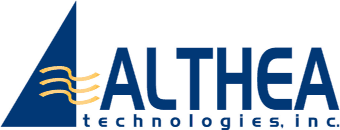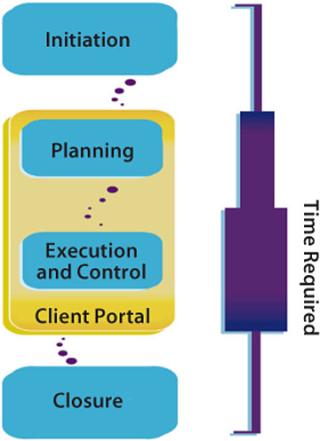
Effectively working with a contract manufacturer’s project management team to ensure project success is a key goal for not only Althea Technologies, but for all companies working on difficult and complex manufacturing projects. Project management tools are widely used to effectively manage biotechnology and pharmaceutical product development. Implementing a project management office (PMO) is still a challenging undertaking for a contract manufacturing organization that has a wide array of project requirements to address. There are a number of models for effective PM strategy including ISO 9000 (www.iso.org), PMBOK (www.pmi.org) and Prince2 (www.ogc.gov.uk) among many others. Generally, the PMO becomes involved at the final stages of a deal close and oversees activities throughout the project life cycle (PLC) shown in Figure 1.
The PLC is a set of four generalized steps composed of activities from initiation through closure. Although the time required for the first and last steps is much less than that required for the two middle activities (project planning and execution) thoroughly understanding project objectives and priorities is critical to ensuring successful project planning and execution. In terms of communicating between the PMO and client, the tools are somewhat limited. Options usually range from weekly conference calls to daily emails and Gantt charts, all involving a larger than necessary team — on both sides — to keep all team members appraised of all project updates.
According to the Project Management institute’s guide termed “Project Management Body of Knowledge” or PMBOK, there are generally three themes to program/project management described: benefits management, stakeholder management, and program governance. Communication between CMOs and clients most closely fits into the stakeholder management style because there are a number of key stakeholders from PMs through the very distinct needs of individual clients. Additionally, each plays a critical role in the project’s success, and therefore, quite a lot of communication occurs between PMO and client. This massive amount of communication, however, can create considerable problems for the stakeholders, ranging from large amounts of email to multiple versions of the same documents and timeline review issues, not to mention a number of security issues.
To enable more effective communication, Althea has developed an interactive client portal designed to provide a mechanism for secured exchange of information. It is a full-fledged project management tool offering document mastering tools, project timeline management tools, access to standard documents, and a variety of ways to communicate. Much of the PLC time requirements for the second and third stages are spent communicating through documents, email, timeline reviews, and so on.
The client portal system replaces the way documents are exchanged and in other cases makes communication more transparent, especially regarding timelines and getting answers to common questions. Documents can now be uploaded through a secure 128-bit encryption system into a document server behind a robust firewall, far more secure than transmission by email. Additionally, a document mastering feature allows only one person at a time to work on any key document, preventing multiple versions of the same document. Gantt charts and other timeline information can be generated directly from the portal. The critical benefit of a shared web-based portal is that it allows any stakeholder, anywhere in the world, to see everything relating to a project at a convenient glance. As this product is deployed more widely, additional applications and functionality may be easily added.
Project management tools are plentiful, but many off-the-shelf versions have functionality that is redundant, in excess, or does not meet unique user requirements without significant modification and expense. Althea’s deployment of the client portal is an example of how cost-effective software-as-a-service (SaaS) tools can provide powerful solutions, without the burden of difficult and expensive installation. On a very basic level, this tool addresses communication challenges by ensuring that all project team members receive communication regarding updates or changes to project details.

